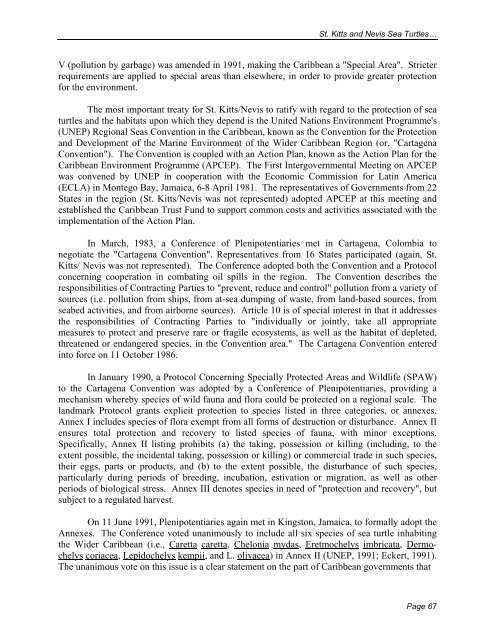Sea Turtle Recovery Action Plan for St. Kitts and Nevis - WIDECAST
Sea Turtle Recovery Action Plan for St. Kitts and Nevis - WIDECAST
Sea Turtle Recovery Action Plan for St. Kitts and Nevis - WIDECAST
You also want an ePaper? Increase the reach of your titles
YUMPU automatically turns print PDFs into web optimized ePapers that Google loves.
<strong>St</strong>. <strong>Kitts</strong> <strong>and</strong> <strong>Nevis</strong> <strong>Sea</strong> <strong>Turtle</strong>s…<br />
V (pollution by garbage) was amended in 1991, making the Caribbean a "Special Area". <strong>St</strong>ricter<br />
requirements are applied to special areas than elsewhere, in order to provide greater protection<br />
<strong>for</strong> the environment.<br />
The most important treaty <strong>for</strong> <strong>St</strong>. <strong>Kitts</strong>/<strong>Nevis</strong> to ratify with regard to the protection of sea<br />
turtles <strong>and</strong> the habitats upon which they depend is the United Nations Environment Programme's<br />
(UNEP) Regional <strong>Sea</strong>s Convention in the Caribbean, known as the Convention <strong>for</strong> the Protection<br />
<strong>and</strong> Development of the Marine Environment of the Wider Caribbean Region (or, "Cartagena<br />
Convention"). The Convention is coupled with an <strong>Action</strong> <strong>Plan</strong>, known as the <strong>Action</strong> <strong>Plan</strong> <strong>for</strong> the<br />
Caribbean Environment Programme (APCEP). The First Intergovernmental Meeting on APCEP<br />
was convened by UNEP in cooperation with the Economic Commission <strong>for</strong> Latin America<br />
(ECLA) in Montego Bay, Jamaica, 6-8 April 1981. The representatives of Governments from 22<br />
<strong>St</strong>ates in the region (<strong>St</strong>. <strong>Kitts</strong>/<strong>Nevis</strong> was not represented) adopted APCEP at this meeting <strong>and</strong><br />
established the Caribbean Trust Fund to support common costs <strong>and</strong> activities associated with the<br />
implementation of the <strong>Action</strong> <strong>Plan</strong>.<br />
In March, 1983, a Conference of Plenipotentiaries met in Cartagena, Colombia to<br />
negotiate the "Cartagena Convention". Representatives from 16 <strong>St</strong>ates participated (again, <strong>St</strong>.<br />
<strong>Kitts</strong>/ <strong>Nevis</strong> was not represented). The Conference adopted both the Convention <strong>and</strong> a Protocol<br />
concerning cooperation in combating oil spills in the region. The Convention describes the<br />
responsibilities of Contracting Parties to "prevent, reduce <strong>and</strong> control" pollution from a variety of<br />
sources (i.e. pollution from ships, from at-sea dumping of waste, from l<strong>and</strong>-based sources, from<br />
seabed activities, <strong>and</strong> from airborne sources). Article 10 is of special interest in that it addresses<br />
the responsibilities of Contracting Parties to "individually or jointly, take all appropriate<br />
measures to protect <strong>and</strong> preserve rare or fragile ecosystems, as well as the habitat of depleted,<br />
threatened or endangered species, in the Convention area." The Cartagena Convention entered<br />
into <strong>for</strong>ce on 11 October 1986.<br />
In January 1990, a Protocol Concerning Specially Protected Areas <strong>and</strong> Wildlife (SPAW)<br />
to the Cartagena Convention was adopted by a Conference of Plenipotentiaries, providing a<br />
mechanism whereby species of wild fauna <strong>and</strong> flora could be protected on a regional scale. The<br />
l<strong>and</strong>mark Protocol grants explicit protection to species listed in three categories, or annexes.<br />
Annex I includes species of flora exempt from all <strong>for</strong>ms of destruction or disturbance. Annex II<br />
ensures total protection <strong>and</strong> recovery to listed species of fauna, with minor exceptions.<br />
Specifically, Annex II listing prohibits (a) the taking, possession or killing (including, to the<br />
extent possible, the incidental taking, possession or killing) or commercial trade in such species,<br />
their eggs, parts or products, <strong>and</strong> (b) to the extent possible, the disturbance of such species,<br />
particularly during periods of breeding, incubation, estivation or migration, as well as other<br />
periods of biological stress. Annex III denotes species in need of "protection <strong>and</strong> recovery", but<br />
subject to a regulated harvest.<br />
On 11 June 1991, Plenipotentiaries again met in Kingston, Jamaica, to <strong>for</strong>mally adopt the<br />
Annexes. The Conference voted unanimously to include all six species of sea turtle inhabiting<br />
the Wider Caribbean (i.e., Caretta caretta, Chelonia mydas, Eretmochelys imbricata, Dermochelys<br />
coriacea, Lepidochelys kempii, <strong>and</strong> L. olivacea) in Annex II (UNEP, 1991; Eckert, 1991).<br />
The unanimous vote on this issue is a clear statement on the part of Caribbean governments that<br />
Page 67
















